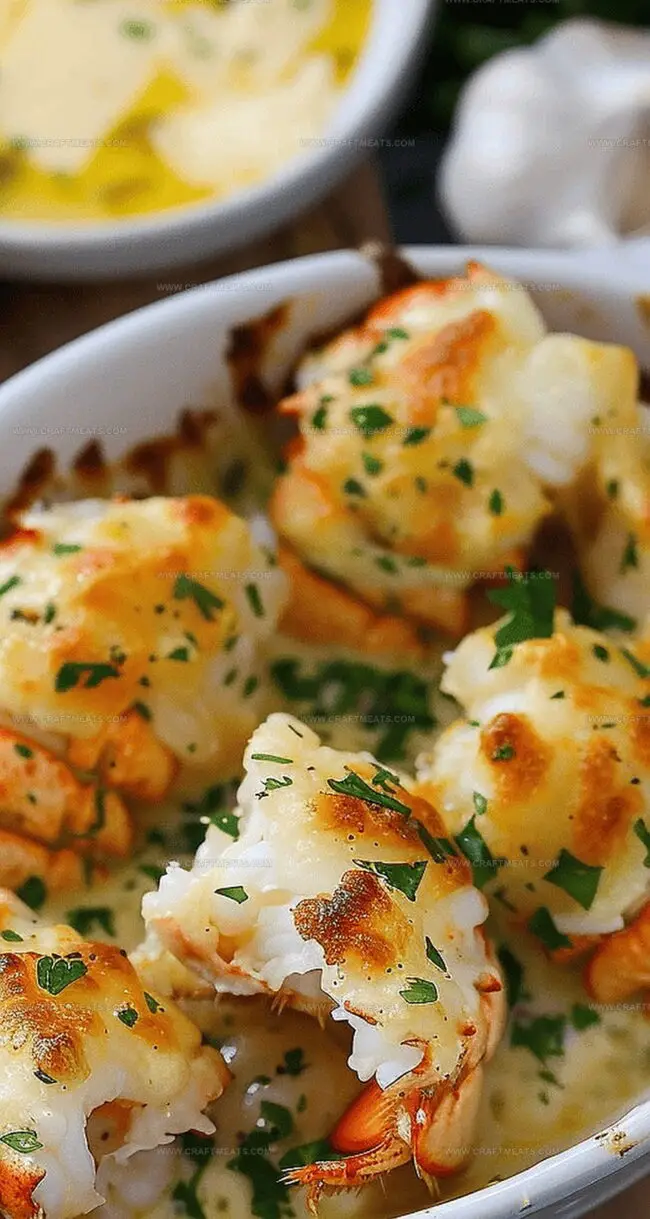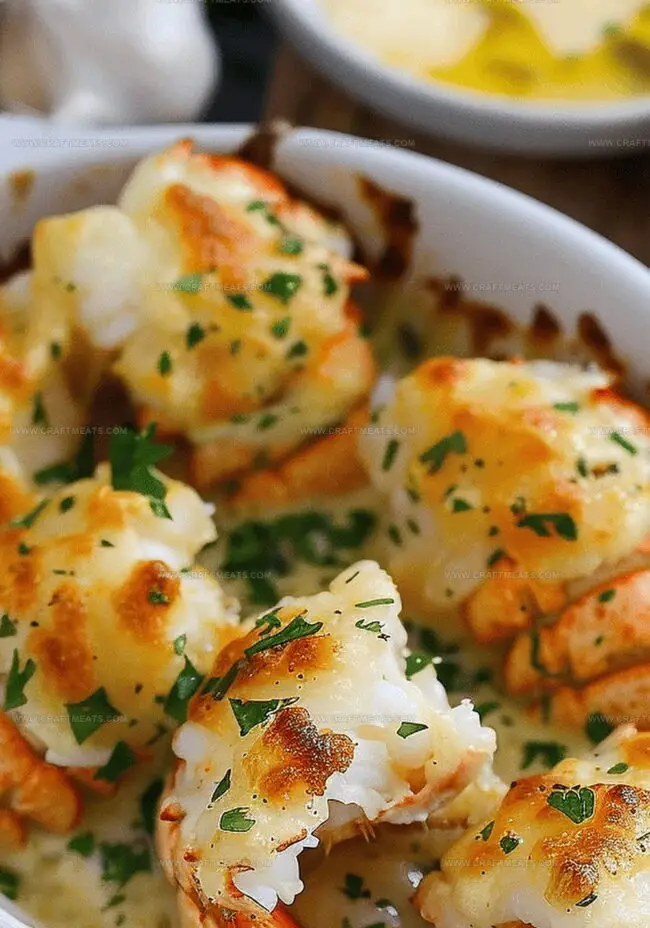Lobster Cargot Bites Recipe to Impress Guests
Succulent lobster cargot delight promises a culinary adventure that whisks you into elegant French coastal cuisine.
Imagine tender seafood nestled in rich, buttery sauce with herbaceous hints of sophistication.
Marine flavors dance across your palate, creating an unexpected gastronomic experience.
Classic techniques merge with contemporary plating to produce something truly memorable.
Delicate ingredients combine in a harmonious composition that feels both luxurious and approachable.
Subtle nuances elevate this dish from ordinary to extraordinary, challenging traditional seafood expectations.
You can find yourself transported by a recipe that celebrates maritime elegance with remarkable depth and complexity.
Explore this extraordinary culinary journey that promises to delight and surprise.
Why You’ll Love Lobster Cargot Delight
Lobster Cargot Delight Ingredient Breakdown
Main Protein:Flavor Enhancers:Cheese Component:How to Make Lobster Cargot Delight at Home
Step 1: Prepare the Oven
Crank up your oven to a toasty 400 degrees Fahrenheit, getting ready for a culinary adventure.
Step 2: Liberate the Lobster Meat
Grab your kitchen shears and carefully slice a long slit down the top of each lobster tail shell. Gently remove the tender meat and chop it into delectable 1-inch chunks.
Step 3: Create the Flavor Base
Melt butter until it’s smooth and golden. Pour the liquid gold into an escargot baking dish, filling each slot with promise. Sprinkle in these aromatic ingredients:Nestle the lobster pieces into each slot, giving them a luxurious bath in the garlic butter mixture.
Step 4: Add the Cheesy Crown
Generously shower shredded havarti cheese over the lobster, creating a blanket of creamy goodness.
Step 5: Bake to Perfection
Slide the dish into the preheated oven. Bake for 2 minutes, then switch to broil for an additional 2 minutes. Watch as the cheese melts and the edges turn golden and irresistible.
Step 6: Serve and Savor
Bring out your masterpiece and get ready to indulge in a mouthwatering lobster experience that will transport your taste buds to seafood heaven.
Tips for Cooking Lobster Cargot Delight
Best Storage Methods for Lobster Cargot Delight
Pairing Suggestions for Lobster Cargot Delight
Creative Variations of Lobster Cargot Delight
Lobster Cargot Delight FAQs
Yes, you can substitute with gruyère or mozzarella. Choose a cheese that melts well and complements seafood flavors.
Look for opaque white meat and avoid overcooking. The lobster should be tender and take about 4 minutes total cooking time at 400°F.
Serve with crusty French bread to soak up the garlic butter, or pair with a light salad and white wine for a complete meal.
You can prep the lobster and garlic butter mixture in advance, but cook just before serving to maintain the best texture and flavor.
Print
Lobster Cargot Delight Recipe
- Total Time: 19 minutes
- Yield: 2 1x
Description
Succulent French-inspired Lobster Cargot Delight brings marine elegance to classic escargot preparation. Buttery garlic notes and tender lobster meat create an unforgettable culinary experience you’ll savor with Mediterranean-style sophistication.
Ingredients
Main Protein:
- 2–3 raw lobster tails, cut into 1-inch chunks
Dairy and Cheese:
- 4 tablespoons (60 milliliters) butter, melted
- ¾ cup (180 milliliters) creamy havarti cheese, shredded
Herbs and Aromatics:
- 4 garlic cloves, finely minced
- ½ tablespoon (7.5 milliliters) fresh parsley, finely minced
Instructions
- Carefully prepare the lobster tails by using kitchen shears to create a precise lengthwise incision along the top of each shell, gently extracting the delicate meat.
- Transform the lobster meat into elegant one-inch bite-sized chunks, ensuring uniform cooking and presentation.
- Generously coat an authentic escargot baking dish with richly melted butter, infusing the ceramic slots with aromatic minced garlic and freshly chopped parsley.
- Artfully nestle the prepared lobster pieces into each buttery compartment, ensuring they are completely enveloped by the fragrant garlic herb mixture.
- Lavishly blanket the lobster morsels with a generous layer of finely shredded havarti cheese, creating a luxurious molten topping.
- Position the elegantly prepared dish into a preheated oven set at 400 degrees fahrenheit, allowing the initial baking to occur for two minutes.
- Switch the oven setting to broil, intensifying the heat to create a perfectly golden, slightly crisp cheese crust for an additional two minutes.
- Carefully remove the dish, letting the lobster cargot rest momentarily before serving to allow the flavors to harmonize and the cheese to settle.
Notes
- Prep ahead by having all ingredients measured and ready before starting to ensure a smooth cooking process.
- Use kitchen shears for precise shell cutting and meat removal to maintain the lobster’s delicate texture.
- Select fresh, high-quality lobster tails for the most succulent and flavorful results.
- Broiling creates a golden, crispy cheese topping that enhances the rich garlic butter and tender lobster meat.
- Serve immediately after cooking to enjoy the optimal temperature and prevent the cheese from cooling and hardening.
- Pair with crusty bread to soak up the delicious garlic butter sauce for a complete gourmet experience.
- Prep Time: 15 minutes
- Cook Time: 4 minutes
- Category: Appetizer, Dinner
- Method: Baking
- Cuisine: French
Nutrition
- Serving Size: 2
- Calories: 432
- Sugar: 1g
- Sodium: 550mg
- Fat: 36g
- Saturated Fat: 20g
- Unsaturated Fat: 14g
- Trans Fat: 0g
- Carbohydrates: 3g
- Fiber: 0g
- Protein: 24g
- Cholesterol: 140mg




Isabella Rossi
Founder & Culinary Content Creator
Expertise
Recipe Development, Traditional Irish and European Cuisines, Food Styling and Photography, Culinary Education
Education
Dublin Institute of Technology (DIT) – School of Culinary Arts and Food Technology
Ballymaloe Cookery School
Liam is the voice behind many of Craft Meats’ most flavorful features. With roots in Dublin’s smoky barbecue scene and a culinary degree from the Dublin Institute of Technology, he brings time-tested cooking techniques to life.
His training at Ballymaloe Cookery School sharpened his farm-to-table approach, giving him a deep respect for every ingredient he writes about.
He’s not about overcomplicating the process, just helping you cook meat that’s worth talking about. When he’s not writing or grilling, he’s out foraging or nerding out on regional spice blends to add to his next recipe.